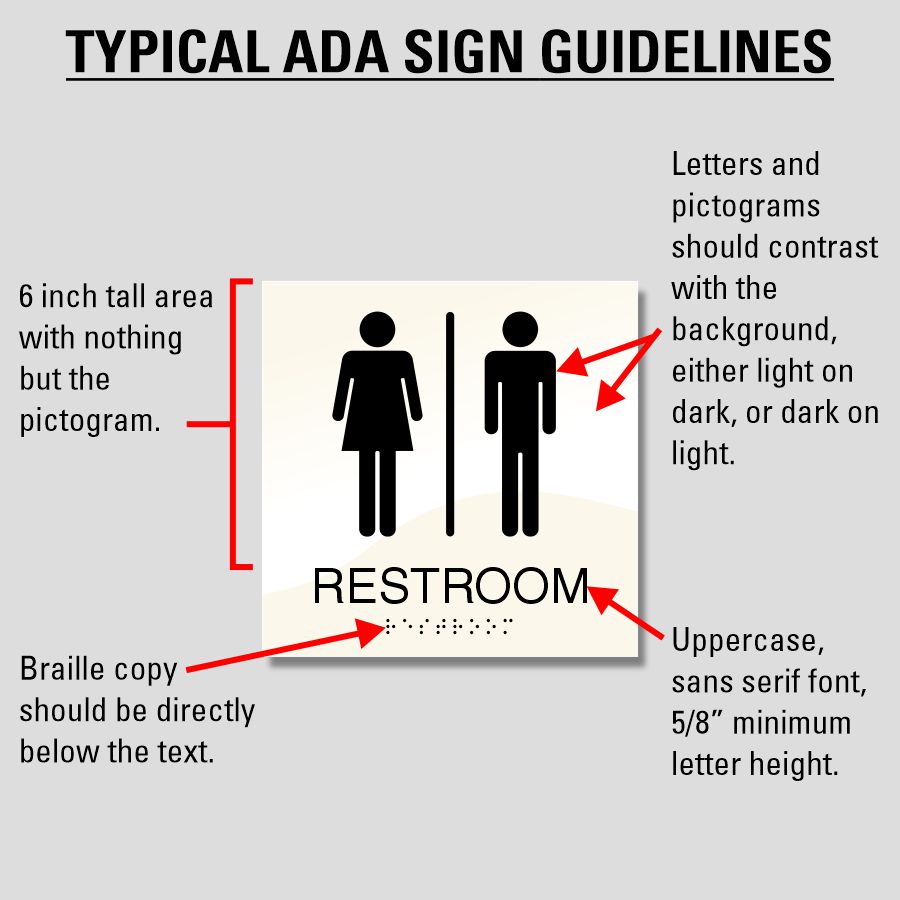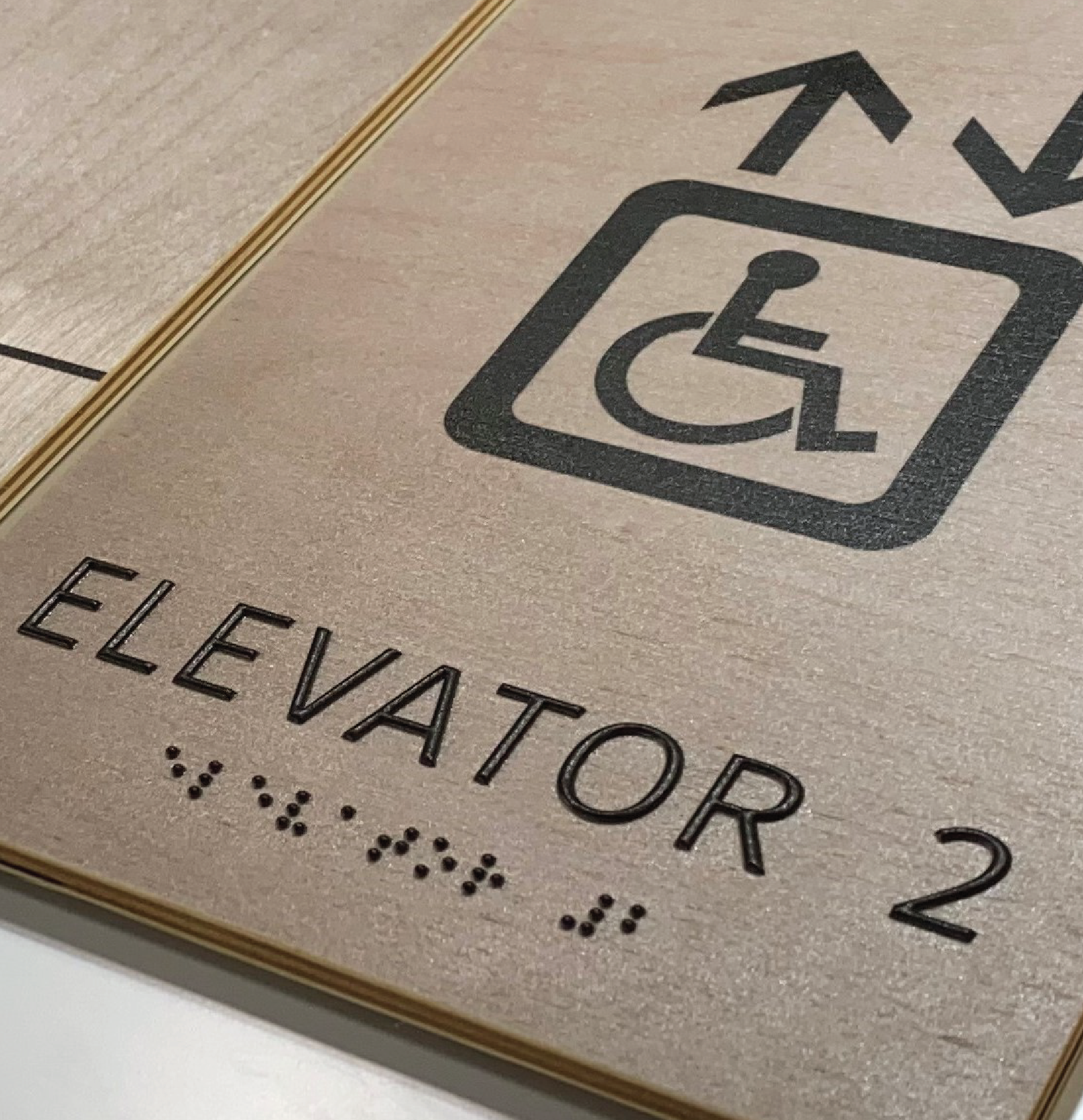Customizing ADA Signs to Satisfy Your Certain Demands
Customizing ADA Signs to Satisfy Your Certain Demands
Blog Article
Discovering the Secret Attributes of ADA Signs for Boosted Access
In the world of ease of access, ADA indications function as quiet yet powerful allies, ensuring that rooms are accessible and inclusive for individuals with impairments. By integrating Braille and responsive elements, these indications damage obstacles for the aesthetically impaired, while high-contrast color design and readable fonts deal with diverse visual needs. Their strategic placement is not arbitrary but instead a calculated effort to assist in seamless navigating. Yet, past these attributes exists a much deeper story regarding the advancement of inclusivity and the continuous dedication to developing equitable rooms. What a lot more could these indications signify in our quest of global accessibility?
Importance of ADA Conformity
Making certain compliance with the Americans with Disabilities Act (ADA) is important for fostering inclusivity and equivalent accessibility in public rooms and work environments. The ADA, enacted in 1990, mandates that all public facilities, employers, and transportation services fit individuals with disabilities, ensuring they enjoy the same rights and possibilities as others. Compliance with ADA standards not just meets legal commitments however likewise boosts a company's online reputation by showing its dedication to variety and inclusivity.
One of the essential facets of ADA conformity is the execution of obtainable signs. ADA signs are created to ensure that people with disabilities can quickly navigate through spaces and buildings.
Additionally, adhering to ADA policies can alleviate the risk of legal consequences and possible penalties. Organizations that fall short to conform with ADA guidelines may encounter charges or legal actions, which can be both economically difficult and harmful to their public image. Therefore, ADA compliance is integral to promoting an equitable setting for everybody.
Braille and Tactile Elements
The incorporation of Braille and responsive elements into ADA signs personifies the concepts of ease of access and inclusivity. These features are crucial for people that are visually damaged or blind, enabling them to navigate public areas with greater freedom and confidence. Braille, a tactile writing system, is important in supplying written information in a layout that can be easily regarded with touch. It is normally placed beneath the corresponding text on signs to make certain that people can access the info without aesthetic assistance.
Responsive elements extend beyond Braille and include raised icons and characters. These parts are made to be discernible by touch, permitting people to identify room numbers, bathrooms, departures, and various other vital areas. The ADA sets details standards concerning the size, spacing, and placement of these tactile elements to maximize readability and make certain uniformity across different environments.

High-Contrast Color Pattern
High-contrast color pattern play a pivotal role in improving the exposure and readability of ADA signage for individuals with visual problems. These plans are important as they take full advantage of the difference in light reflectance in between text and history, making sure that indications are quickly discernible, even from a distance. The Americans with Disabilities Act (ADA) mandates making use of certain shade contrasts to accommodate those Read More Here with restricted vision, making it an essential aspect of conformity.
The effectiveness of high-contrast shades hinges on their ability to stick out in numerous illumination conditions, including dimly lit environments and locations with glow. Generally, dark message on a light background or light text on a dark background is employed to accomplish ideal contrast. Black message on a yellow or white background gives a stark visual difference that aids in quick acknowledgment and understanding.

Legible Fonts and Text Size
When taking into consideration the design of ADA signs, the selection of legible fonts and ideal message dimension can not be overemphasized. The Americans with Disabilities Act (ADA) mandates that typefaces need to be not italic and sans-serif, oblique, manuscript, highly decorative, or of uncommon form.
According to ADA guidelines, the minimum text elevation should be 5/8 inch, and it should increase proportionally with viewing range. Uniformity in message dimension adds to a natural aesthetic experience, helping people in navigating environments effectively.
Moreover, spacing between letters and lines is important to readability. Adequate spacing protects against characters from appearing crowded, enhancing readability. By adhering to these criteria, designers can substantially enhance ease of access, making certain that signs serves its desired objective for all people, regardless of their aesthetic capabilities.
Effective Positioning Techniques
Strategic positioning of ADA signs is important for making the most of availability and guaranteeing conformity with lawful criteria. Effectively located signs direct individuals with impairments effectively, helping with navigating in public areas. Secret considerations consist of height, distance, and presence. ADA guidelines state that indications should be placed at a height in between 48 to 60 inches from the ground to ensure they are within the line of view for both standing and seated people. This typical height variety is essential for inclusivity, enabling mobility device customers and individuals of differing heights to accessibility information effortlessly.
Furthermore, indications should be put adjacent to the latch side of doors to permit very easy identification before access. Uniformity in sign placement throughout a facility improves predictability, minimizing confusion and enhancing total user experience.

Final Thought
ADA indications play an important duty in promoting ease of access by incorporating features that address the needs of individuals with disabilities. These components jointly promote an inclusive atmosphere, highlighting the importance of ADA conformity in guaranteeing equal access for all.
In the realm of availability, ADA signs serve as quiet yet powerful allies, making sure that spaces are navigable and inclusive for individuals with specials needs. The ADA, passed in 1990, mandates that all public facilities, companies, and transport services fit individuals with specials needs, ensuring they appreciate the exact same legal rights and opportunities as others. ADA Signs. ADA indicators are made to make sure that individuals with disabilities can easily navigate with structures and special info areas. ADA standards stipulate that indications must be placed at an elevation in between 48 to 60 inches from the ground to ensure they are within the line of view for both standing and seated individuals.ADA indications play an essential role in promoting access by integrating attributes that attend to the demands of people with impairments
Report this page